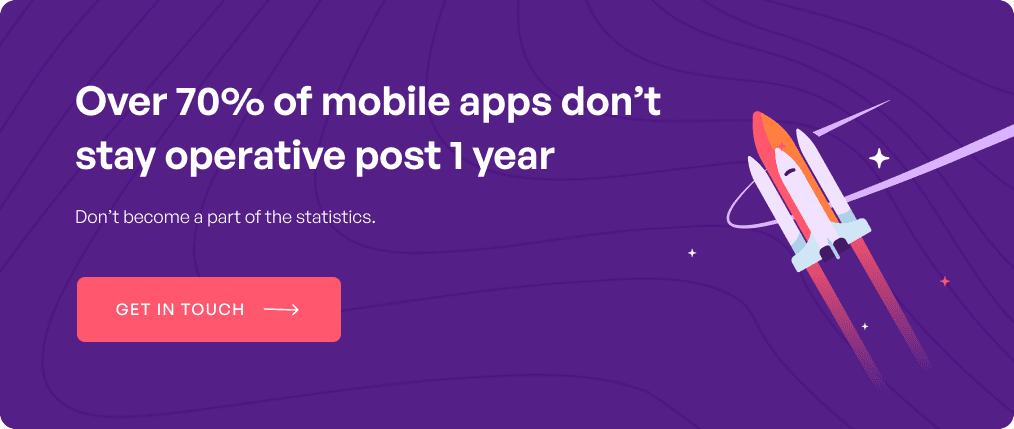There are two types of entrepreneurs. One who goes all in with an idea they believe in and the second, who runs a thorough market research to build, deploy a digital product. Now the probability of the first category entrepreneurs to succeed, while there, is extremely luck based, on the other hand, the second category entrepreneurs have a much greater chance of success owing to the efforts they have put in the homework.
But how do you transition from being category one entrepreneur to category two? The answer to this is through digital product idea validation – an absence of which can have a dire impact on your business success. Let us explain how.
According to a recent find by Businessofapps, the cost of developing a medium complexity app is anywhere between $32K to $48K and the number of applications in the stores has grown to 2.18 million in App Store plus 2.65 million of the Play Store. A combination that has created a situation where one wrong decision can make your app a failure the moment you launch it in the overcrowded app stores. Digital product validation, comes as an ideal solution to addressing this situation.

Even when you build a market research backed digital solution, its success would depend on how effectively you answer these four questions –
- Do enough people want it?
- Are those people willing to pay for it?
- Is the app idea unique?
- Can they find your digital product easily?
Let us look into the ways you can get answers to these questions by looking into the digital product validation process.
Table of contents
The ways of validating digital product ideas
On papers validating an app idea is fairly straightforward. You look into the competition, talk to your prospective user base, and run technical feasibility tests to get a clarity on whether your digital product will be accepted. In reality, it is a multi-phases process.
Define user personas
One of the sure shot ways to validate a product idea is to fix the user persona and check if your app idea would meet their needs. At Neojn, when we build a user persona, we identify and combine both demographics and psychographic information of your prospective users. While the demographic side of a persona consists of information around age, gender, profession, income, and in some cases marital status, the psychographic profile is much more in-depth.
In case of psychographic persona creation, we look into the users’ goals, their motivators, frustrations, and create a rough look into their day – highlighting the instance where they will use your application.
Once you have drafted the user persona, the next step that comes is putting your application in the centre of their life and measuring the scope of acceptance.
Market size estimation
If we ask you whether you would build an app if there were 1 million potential customers vs if there were 1,000 users? I am sure you would say that you’d build a digital product only when you have a million potential customers. But how do you estimate that approximate number? The best way to approach this is by looking into the number of people talking about your idea or product concept through any keyword research tool.
You can enter the primary keyword, in this case {your app category} + {app} in keyword research tools like Google Keyword Planner or Semrush, etc and look into its search volume in your selected region.
Now, it is one thing to know the current demand of your application’s concept and completely another to gauge the future demand of the idea. The solution to this again lies with performing past data market research through platforms like Google Trends.
Users’ willingness to pay
The demand for an application or digital product is irrelevant for a business if the sector’s audience is not willing to pay for using the application. The easiest way to measure if your potential users will make in-app payment is to divide the total revenues by total downloads. The resultant number will give you a rough idea into users’ willingness to pay and the amount they are comfortable with.
In addition to this, platforms like Sensor Tower and App Annie also offer services around tracking revenues earned through in-app purchases. Using these platforms will give you an idea of what to expect from your application concept in terms of revenue.
Scope of entry
A key part of product concept validation is to know if there is a scope for new apps to enter the category. Here are a few ways to find a concrete answer to this question.
- Look into the age of the apps active in the category. If the majority of the category is made up of old applications, it is a good sign that it is difficult for a new application to enter the market since it’s highly competitive.
- Look into the competitor apps’ reviews and ratings. If the users are not enjoying these apps, chances are they will be willing to put in their money and time in new solutions that address those issues perfectly.
- Look at the reliance on advertisements. If the top applications of your category are investing heavily on advertisements, you can be rest assured that you will also have to compete for that ad space to get your users’ attention.
How does Neojn help you with digital product idea validation?
In our role as a digital product design company, we have helped a number of startups, across industries, solidify their digital product concept at the back of a detailed market and technical feasibility check. The way we do that is through our extensive Discovery Workshop session, which forms a critical part of our digital product development process.
In this phase, we run a competitive and market analysis on your application to ensure that your USPs are clearly defined plus accepted in the digital space. Additionally, we involve real users in the process to check that the concept you are planning to build is aligned with their goals and motivations.
While our research and business analysis teams work with you on establishing market validation, our tech team looks into the solution’s technical readiness on platforms you are planning to launch the solution on and ensures that the feature you are planning to add is actually buildable.
Explore the benefits of partnering with our digital product design agency. Get in touch with our team today.

